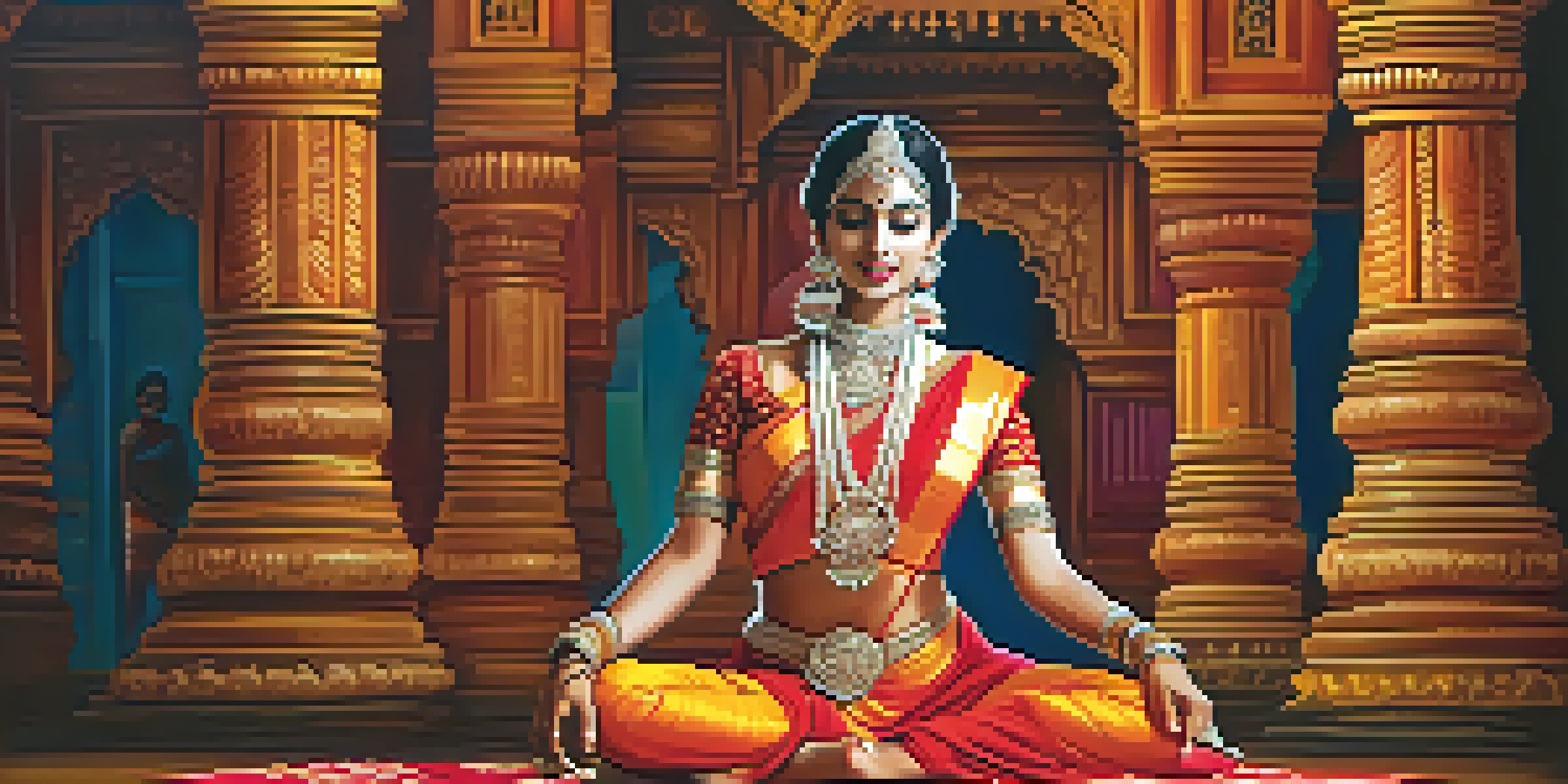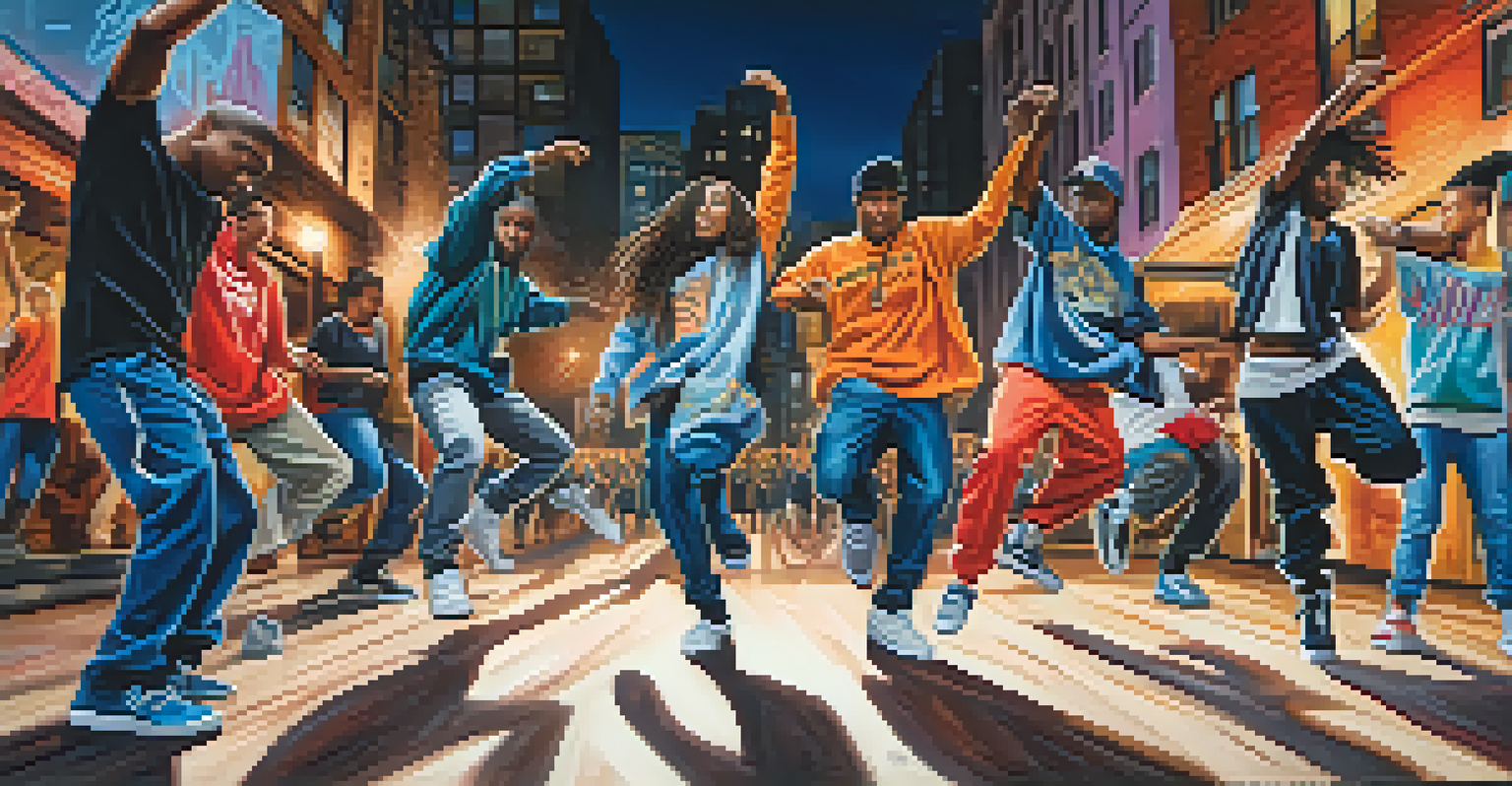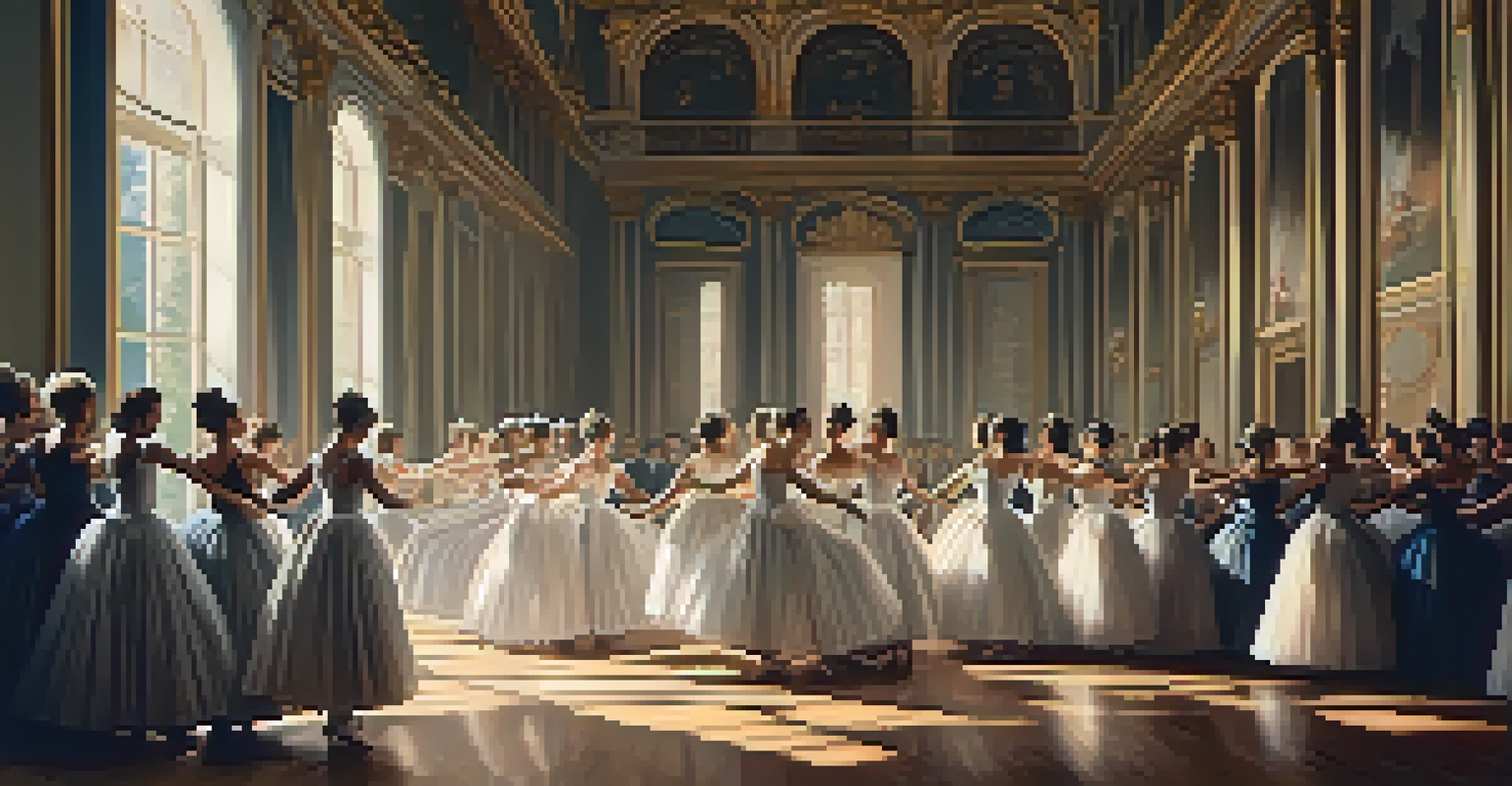Historical Events Captured Through Dance Choreography

The Role of Dance in Historical Storytelling
Dance has long been a powerful medium for storytelling, allowing cultures to convey their histories in a dynamic way. From ancient rituals to contemporary performances, choreography can encapsulate the essence of historical events, providing depth and emotion. By moving through space and time, dancers bring stories to life, making them accessible to audiences who may not be familiar with the events.
Dance is the hidden language of the soul.
For instance, the traditional dances of indigenous peoples often tell stories of creation and survival, passing down knowledge through generations. Each movement can represent an element of history, transforming abstract concepts into tangible experiences. This connection between movement and memory emphasizes the importance of dance as a living archive of human experience.
Moreover, as societies evolve, so too does the way we interpret history through dance. Choreographers frequently draw inspiration from significant events, using their art to comment on, critique, or celebrate the past. In this way, dance not only preserves history but also invites reflection and discussion about its implications in our present.
Ballet and the French Revolution
Ballet, often associated with elegance and grace, played a surprising role during the French Revolution. Choreographers began to incorporate themes of rebellion and passion into their works, reflecting the turbulent social landscape of the time. Dances that once celebrated monarchy transformed into powerful expressions of liberty and equality, showcasing the potential for art to influence and reflect societal change.

One notable example is the ballet 'La Fille Mal Gardée,' which, while not explicitly about the revolution, captured the spirit of the era through its themes of love and defiance against societal norms. The evolution of ballet during this period demonstrates how choreography can serve as a canvas for political and social commentary. This shift helped to democratize the art form, making it more accessible and relevant to the masses.
Dance as a Storytelling Medium
Dance serves as a dynamic form of storytelling, allowing cultures to convey their histories and emotions through movement.
In essence, the dance world mirrored the revolutionary fervor of the time, allowing artists to engage with contemporary issues. This historical connection highlights how ballet is not just a performance art but also a reflection of the collective consciousness during pivotal moments in history.
Modern Dance and Civil Rights Movement
The Civil Rights Movement in the United States saw a significant intersection with the world of modern dance. Pioneers like Martha Graham and Alvin Ailey used their choreography to address social justice issues and advocate for equality. Their performances not only entertained but also educated audiences about the struggles faced by African Americans, making dance a powerful tool for social change.
The dance can reveal everything mysterious that is hidden in music and it can change the world.
Alvin Ailey's 'Revelations,' for example, is a celebrated piece that draws from African American spirituals and illustrates the journey from despair to hope. Through movement, Ailey conveyed the emotional weight of the African American experience, creating a visceral connection with viewers. This blending of art and activism encouraged audiences to reflect on the ongoing fight for civil rights.
Furthermore, modern dance allowed for a more personal expression of the struggles faced during this era. Dancers often infused their own experiences into their performances, making the choreography deeply relatable. This personal touch not only preserved historical narratives but also inspired future generations to continue the fight for justice and equality.
Bharatanatyam and India's Independence
Bharatanatyam, one of the oldest classical dance forms in India, has been pivotal in narrating the country's history, particularly during its struggle for independence. Traditionally performed by temple dancers, this dance evolved into a medium for expressing cultural identity and national pride. As India faced colonial rule, Bharatanatyam became a symbol of resistance and self-assertion.
Choreographers began to integrate themes of freedom and patriotism into their performances, utilizing the dance's intricate footwork and expressive gestures. The revival of Bharatanatyam in the early 20th century was closely tied to the independence movement, with dancers like Rukmini Devi Arundale playing a key role in its resurgence. Her efforts not only preserved this art form but also positioned it as a vehicle for political expression.
Historical Context in Choreography
Choreographers often draw inspiration from significant historical events, using dance to reflect, critique, and celebrate societal changes.
Today, Bharatanatyam continues to celebrate India's rich heritage while reflecting on its historical struggles. The dance form serves as a reminder of the power of art to unite and inspire collective action, illustrating how choreography can encapsulate the spirit of a nation.
Hip-Hop and Social Commentary
Hip-hop dance, rooted in urban culture, has emerged as a vibrant form of expression that often addresses social issues. Originating in the streets of New York City, hip-hop reflects the realities of marginalized communities, making it a powerful tool for storytelling. Through its dynamic movements and rhythms, hip-hop dancers convey messages about inequality, violence, and resilience.
For example, the choreography seen in performances by groups like the Jabbawockeez often tackles themes of identity and struggle. Their pieces resonate with audiences, sparking conversations about societal challenges while celebrating cultural heritage. This ability to address pressing issues through dance underscores hip-hop's role as both an art form and a medium for social commentary.
Moreover, hip-hop has the unique capacity to engage younger generations, drawing them into discussions about history and activism. As dancers explore their own narratives through movement, they create a dialogue that transcends words. By doing so, hip-hop dance not only preserves history but also empowers individuals to take action and advocate for change.
The Influence of Dance on Historical Narratives
Dance has a remarkable ability to shape and influence historical narratives, often providing perspectives that traditional history may overlook. Through choreography, artists express their interpretations of events, allowing audiences to experience history in a more visceral way. This immersive approach can evoke emotions and foster empathy, encouraging a deeper understanding of complex issues.
For example, performances that depict war can highlight the human cost of conflict, portraying the pain and loss experienced by individuals and communities. Such artistic representations challenge audiences to confront uncomfortable truths, making history feel more immediate and relevant. In this way, dance becomes a catalyst for reflection and conversation, prompting viewers to reconsider their relationship with the past.
Cultural Preservation Through Dance
Traditional dances embody the values and histories of communities, ensuring cultural heritage is passed down through generations.
Furthermore, the collaborative nature of dance allows for diverse voices to be heard, enriching historical narratives with varied perspectives. Choreographers often draw from their cultural backgrounds, creating performances that reflect the richness of human experience. This diversity not only enhances the art form but also ensures that history is told through multiple lenses, fostering inclusivity and understanding.
Dance as a Tool for Cultural Preservation
In addition to telling stories, dance plays a crucial role in preserving cultural heritage. Traditional dances often embody the values, beliefs, and histories of a community, serving as a living record of their identity. Through teaching and performing these dances, communities ensure that their history is passed down through generations, maintaining a vital connection to their roots.
Many indigenous cultures have used dance as a means of preserving their traditions, with each movement carrying significant meaning. For instance, the powwow dances of Native American tribes are not only celebratory but also serve as a way to honor ancestors and relay important cultural narratives. This practice keeps history alive, reinforcing a sense of belonging and continuity.

Moreover, contemporary choreographers are increasingly incorporating traditional elements into their works, bridging the gap between past and present. This fusion allows for the evolution of dance while respecting its origins, creating a dynamic dialogue between generations. Through this process, dance becomes a powerful means of cultural preservation, reminding us of the importance of honoring our histories.
Conclusion: The Lasting Impact of Dance on History
As we've explored, dance is much more than just a form of entertainment; it's a profound means of capturing and reflecting historical events. From ballet to hip-hop, each dance style offers unique insights into the cultural and social landscapes of their time. By examining these connections, we can appreciate the rich tapestry of human experience woven through movement.
The ability of dance to convey complex emotions and narratives makes it an invaluable tool for understanding history. It invites audiences to engage with the past in a way that is both accessible and impactful, fostering empathy and connection. As we continue to witness the evolution of dance, we can expect it to remain a powerful medium for storytelling and cultural expression.
Ultimately, the history of dance is a testament to the resilience of the human spirit. As artists draw from their experiences to create choreography that reflects their realities, they remind us that history is not a static narrative, but a living, breathing entity that continues to shape our world today.